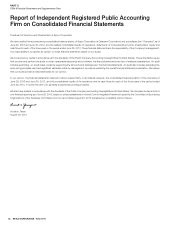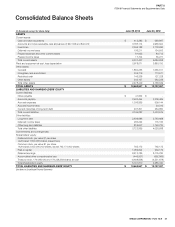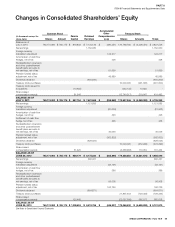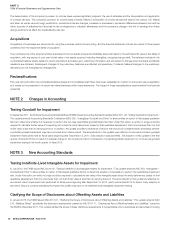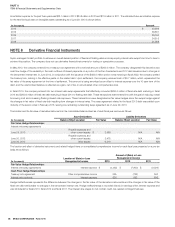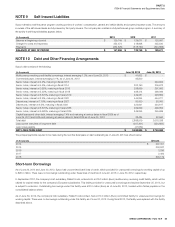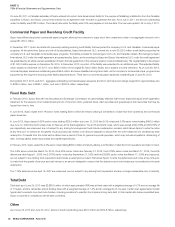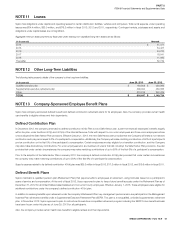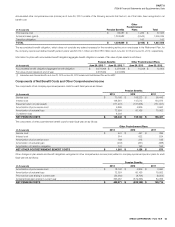Sysco 2013 Annual Report Download - page 65
Download and view the complete annual report
Please find page 65 of the 2013 Sysco annual report below. You can navigate through the pages in the report by either clicking on the pages listed below, or by using the keyword search tool below to find specific information within the annual report.
SYSCO CORPORATION-Form10-K54
PARTII
ITEM8Financial Statements and Supplementary Data
The determination of the company’s provision for income taxes requires signi cant judgment, the use of estimates and the interpretation and application
of complex tax laws. The company’s provision for income taxes primarily re ects a combination of income earned and taxed in the various U.S. federal
and state, as well as various foreign jurisdictions. Jurisdictional tax law changes, increases or decreases in permanent differences between book and tax
items, accruals or adjustments of accruals for tax contingencies or valuation allowances, and the company’s change in the mix of earnings from these
taxing jurisdictions all affect the overall effective tax rate.
Acquisitions
Acquisitions of businesses are accounted for using the purchase method of accounting, and the nancial statements include the results of the acquired
operations from the respective dates of acquisition.
The purchase price of the acquired entities is allocated to the net assets acquired and liabilities assumed based on the estimated fair value at the dates of
acquisition, with any excess of cost over the fair value of net assets acquired, including intangibles, recognized as goodwill. The balances included in the
consolidated balance sheets related to recent acquisitions are based upon preliminary information and are subject to change when nal asset and liability
valuations are obtained. Subsequent changes to the preliminary balances are re ected retrospectively, if material. Material changes to the preliminary
allocations are not anticipated by management.
Reclassifi cations
Prior year amounts within the consolidated balance sheets and consolidated cash ows have been reclassi ed to conform to the current year presentation
as it relates to the presentation of certain tax-related balances within these statements. The impact of these reclassi cations was immaterial to all periods
presented.
NOTE2 Changes in Accounting
Testing Goodwill for Impairment
In September2011, the Financial Accounting Standards Board (FASB) issued Accounting Standards Update (ASU) 2011-08, “Testing Goodwill for Impairment.”
This update amends Accounting Standards Codi cation (ASC) 350, “Intangibles–Goodwill and Other” to allow entities an option to rst assess qualitative
factors to determine whether it is necessary to perform the two-step quantitative goodwill impairment test. Under that option, an entity no longer would be
required to calculate the fair value of a reporting unit unless the entity determines, based on that qualitative assessment, that it is more likely than not that
its fair value is less than its carrying amount. In addition, the update provided a revised list of factors that should be considered when evaluating whether
a potential goodwill impairment may have occurred at an interim period. The amendments in this update were effective for annual and interim goodwill
impairment tests performed for scal years beginning after December15,2011. Early adoption was permitted. The adoption of this update in the rst
quarter of scal 2013 did not result in a material change to the company’s interim consideration of potential goodwill impairment nor to its annual goodwill
impairment testing in the fourth quarter of scal 2013.
NOTE3 New Accounting Standards
Testing Indefi nite-Lived Intangible Assets for Impairment
In July2012, the FASB issued ASU 2012-02, “Testing Inde nite-Lived Intangible Assets for Impairment.” This update amends ASC 350, “Intangibles—
Goodwill and Other” to allow entities an option to rst assess qualitative factors to determine whether it is necessary to perform the quantitative impairment
test. Under that option, an entity no longer would be required to calculate the fair value of the intangible asset unless the entity determines, based on that
qualitative assessment, that it is more likely than not that its fair value is less than its carrying amount. The amendments in this update are effective for
annual and interim impairment tests performed for scal years beginning after September15,2012, which will be scal 2014 for Sysco. Early adoption is
permitted. Sysco is currently evaluating the impact this update may have on its inde nite-lived intangibles impairment testing.
Clarifying the Scope of Disclosures about Offsetting Assets and Liabilities
In January2013, the FASB issued ASU 2013-01, “Clarifying the Scope of Disclosures about Offsetting Assets and Liabilities.” This update amends ASC
210, “Balance Sheet,” speci cally the disclosure requirements created by ASU 2011-11, “Disclosures About Offsetting Assets and Liabilities,” issued by
the FASB in December2011. This update clari es the scope of these disclosure requirements to be applicable only to derivatives and securities borrowing




